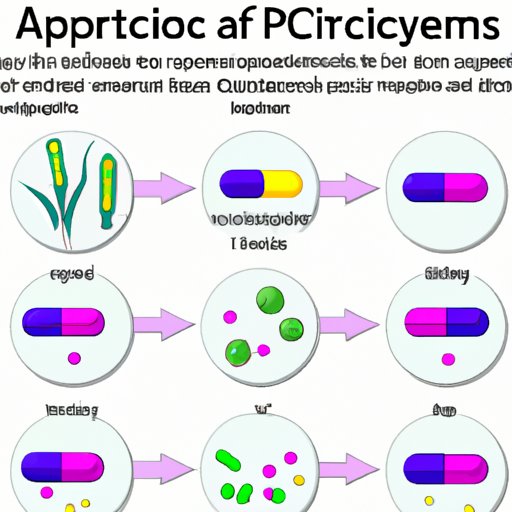Introduction
Antibiotics are medicines used to treat bacterial infections. They work by either killing bacteria or stopping them from multiplying so that the body’s natural defenses can fight off the infection. Antibiotics are essential tools in modern medicine, providing a safe and effective way to treat many common illnesses.
Bacterial infections can range from minor skin irritations to life-threatening conditions such as meningitis and sepsis. Antibiotics are an important tool in treating these infections, as they can help reduce the severity of symptoms and the risk of complications.

Types of Antibiotics and their Mechanism of Action
There are several different classes of antibiotics, each with its own mechanism of action. The most commonly used antibiotics include penicillins and other drugs from the penicillin group, cephalosporins, macrolides, tetracyclines, aminoglycosides, and quinolones.
Penicillins are the oldest class of antibiotics and are derived from fungi. They work by inhibiting the formation of the bacterial cell wall, which prevents the bacteria from multiplying. Cephalosporins are similar to penicillins but have a slightly different chemical structure, making them more effective against certain types of bacteria. Macrolides and tetracyclines are broad-spectrum antibiotics that work by interfering with the bacteria’s ability to produce proteins. Aminoglycosides and quinolones are more powerful antibiotics that target specific parts of the bacterial cell, such as the DNA.
Antibiotic Resistance
Antibiotic resistance occurs when bacteria become resistant to the effects of antibiotics. This means that the antibiotics are no longer effective in treating the infection. Antibiotic resistance is a growing problem, as it is becoming increasingly difficult to find antibiotics that are effective against certain types of bacteria.
The process of antibiotic resistance begins when bacteria are exposed to an antibiotic. Some bacteria are naturally resistant to the antibiotic, while others develop resistance through changes in their genetic material. Over time, these resistant bacteria can spread to other populations of bacteria and make them resistant as well.
The implications of antibiotic resistance are serious, as it can lead to longer-lasting and more severe infections that are difficult to treat. It can also increase the risk of antibiotic-resistant bacteria spreading to other people, leading to more widespread outbreaks of disease.
Taking Antibiotics as Prescribed
It is important to take antibiotics as prescribed by your doctor. Taking too few doses or not completing the course of treatment can leave some bacteria alive, which can lead to antibiotic resistance. Additionally, taking too much of an antibiotic can cause serious side effects.
To ensure proper use of antibiotics, it is important to follow your doctor’s instructions carefully. This includes taking the full course of treatment as prescribed, not skipping doses, and avoiding taking antibiotics for conditions that do not require them, such as the common cold.
Side Effects of Antibiotics
Most people experience mild side effects when taking antibiotics, such as nausea, vomiting, diarrhea, and rashes. These side effects usually go away after a few days. However, some people may experience more serious side effects, such as allergic reactions, kidney damage, and hearing loss.
If you experience any of these side effects, it is important to contact your doctor right away. Your doctor may be able to adjust the dose or switch to a different antibiotic to reduce the risk of serious side effects.
New Research on Antibiotics
Researchers are constantly working to develop new antibiotics to combat antibiotic resistance. One recent study found that a combination of two existing antibiotics was more effective than either drug alone in treating infections caused by a bacterium known as Acinetobacter baumannii.
Other research has focused on developing new antibiotics from natural sources, such as bacteria and fungi. These natural antibiotics are thought to have fewer side effects and be more effective against certain types of bacteria.
Role of Antibiotics in Public Health
Antibiotics play an important role in public health, as they can help to contain the spread of infectious diseases. They can also reduce the severity of symptoms and the risk of complications, allowing people to recover more quickly.
However, overuse of antibiotics can lead to antibiotic resistance and an increased risk of side effects. Therefore, it is important to use antibiotics only when necessary and to follow your doctor’s instructions carefully.
Conclusion
Antibiotics are an important tool in modern medicine, providing a safe and effective way to treat bacterial infections. There are several different classes of antibiotics, each with its own mechanism of action. Antibiotic resistance is a growing problem, as it is becoming increasingly difficult to find antibiotics that are effective against certain types of bacteria. It is important to take antibiotics as prescribed and to be aware of the potential side effects. Finally, antibiotics play an important role in public health, but it is important to use them only when necessary.
(Note: Is this article not meeting your expectations? Do you have knowledge or insights to share? Unlock new opportunities and expand your reach by joining our authors team. Click Registration to join us and share your expertise with our readers.)
